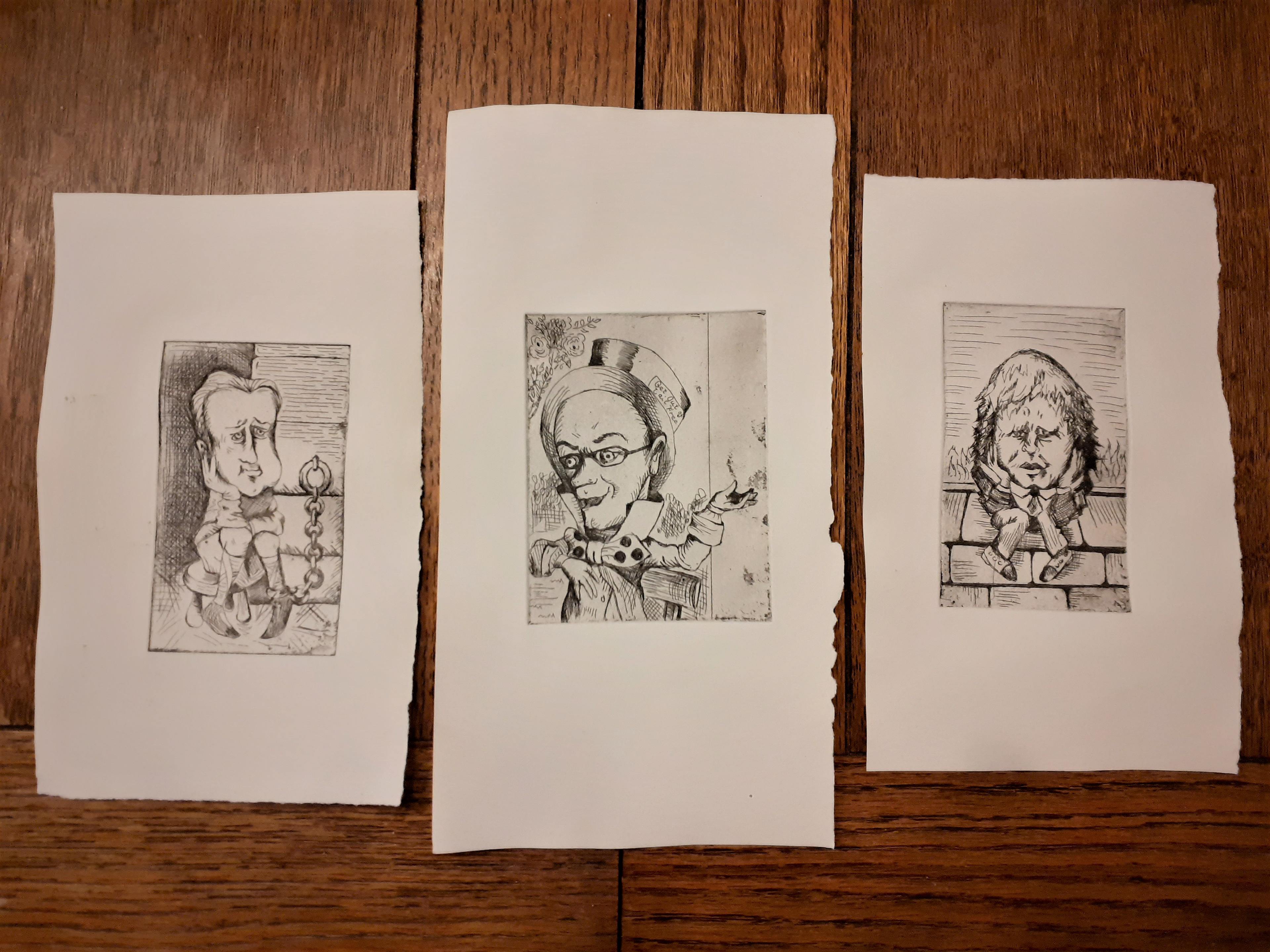Fig.1 Digitally edited photograph
Fig 2. Digitally edited photograph
Hannah Hoch, Deutsches Mädchen (1930)
Hannah Hoch, Cut with the Kitchen Knife (1919)
Government advertisement, September 2020
Promotional Image from 'Grayson Perry's Big American Road Trip', Channel 4 September 2020
Fig 3. Section from my studio visual brainstorm.
Fig 4. Free association photomontage
Fig 5. Free association collage
Fig 6. Free association collage
Section from a New York Post article April 2020
Fig 7. Free association stop frame animation
Fig 8. Tarot animation using Premier Pro
Screenshot of the Photoshop process
Fig 9. 'Eat out to Help out' digital meme
Fig 10. 'Grab Them by the Pussy' digital meme
Fig 11. 'Loo roll back at Tesco' digital meme
Fig 12. 'Is it really round?' digital meme
Fig. 13, Premiere animation trial with 3 Tarot
The original Happy Families game illustrated by John Tenniel
Fig 14. The Trump, ink drawing on paper
Fig 15. The Boris, ink drawing on paper
Fig 16: Cummings in the Rose Garden, ink drawing on paper
Fig 17: Same illustration using acetate drypoint print with water based ink
Fig. 18 Trump mouth in clay
Fig 19. Trump mouth from above
Fig. 20 Trump mouth from the side
Fig. 21. Acetate intaglio print with water based ink
Fig. 22. Copper etching process
Fig. 23. Copper etched plates ready to print with (after acid bath)
Fig 24. Water based acetate prints cut out by hand (scalpel below, combination in middle and scissors on top)
Fig. 24. Boris illustration with Photoshop text
Fig 25. Boris illustration with Tarot typography on Photoshop
Fig 26. Boris illustration with Tarot typography and Photoshop symbols
Fig. 27. Boris illustration with Tarot typography and photoshop artificial colour fill.



Fig. 29. Silk screen with emulsion exposure from card designs (2 designs, 2 sizes)
Fig. 30. Close up of exposure of silk screen, David Cameron card
Fig. 31. Screen prints onto readymade playing cards
The game of 'Suffragetto'
Playing the original Game of Life, 'The Checkered Life'
The original 'Checkered Life' board, including suicide square.
Original 'Land Lord's game' by Elizabeth Magie, 1902.
The Real Game of life by Chris Pender, 1998.
Fig 32. Mock up of potential game mechanics. (This image has many 'You die' spaces as it is at the very end of the game)
Fig. 33. Video of some original trialling of my board on Photoshop
Fig. 34. Early stage of piecing the board together using a scan of the original Game of Life track as a compositional resource.
Vintage Board Games by Adrian Seville
Fig. 35. My Pinterest board of Victorian illustration and drawing techniques for iconology.
Fig. 36. Original pathway mechanism from Game of Life on Photoshop
Fig. 37. My hand drawn ink pen design for the game icon for Relationships
Fig. 38. My hand drawn ink study for the board design
Fig. 39. My design drawn up on Illustrator; beginning to add game mechanisms and symbols as well as consider composition.
Monopoly money design with train logo.
Fig. 40. My money design using illustrator. The money will have different colours for different values, much like Monopoly.
Fig. 41. My designs for the 'Privilege and 'Poverty' cards for my game (using scanned hand drawn images manipulated on photoshop)
Fig 42. Hand drawn pen and ink logos for my cards (scaled, refined and repeated digitally on photoshop)
Fig. 43. Final game playing pieces (hand painted model pieces)
Fig. 44. 'Train' by Brenda Romero
Fig. 45. Lockdown cards with hand printed logo
Fig. 46. Career cards with hand finished logo and colour fill
Fig. 47. Illustrator printout of board design with collage from that day's newspaper.
Fig. 48. Alternatives for board design
Fig. 49. Game pieces with takeout boxes
Fig. 50. Video of rules
Fig. 51 Final 2020 game, professionally printed in the US on a folding board
Fig. 52 Final Video
Fig 53. Photoshop jpeg with text
Fig 54. Photoshop with colour swatches
Fig. 55. Boris in red, screenprint visualisation using Photoshop
Fig. 56. A reverse design in royal blue
Fig. 57. Margaret street Vitrine
Fig. 58. Details on the foyer floor and the vitrine woodwork
Fig. 59. Measurements of the space
Fig. 60. A4 size card maquette
Fig. 61. A3 size card maquette
Fig. 62. The same structure in 130gsm paper (collapses under its own weight)
Fig. 63. The same tower in 220 gsm paper
Fig. 64. Foamboard A4 'collapsing' shape
Fig. 65. 'Impossible' structure in foamboard, A4.
Fig, 66. Final structure design.
Fig. 67 Screenprints drying
Fig. 68 Screenprint frame ready for ink
Fig. 69 The gluing process involving 6 hours of careful placement of metal rods, paper struts and superglue.
Fig. 70 Professional labelling and displaying
Luck Vs Logic, 2021
Foamboard, glue, screenprints
Inspired by research into our rich history of gaming and cards, Katherine Howes’s sculpture raises questions about our political system and playing ‘the game of politics’. The card tower mysteriously survives toppling. Is the glue that keeps it together the good of the people; volunteering, working tirelessly, showing grit and determination in the face of adversity? Or is the tower of Boris Johnsons held up by money and support of lobbyists, big business and the media. How and when will the tower collapse?"
Fig. 71 The final piece in situ.